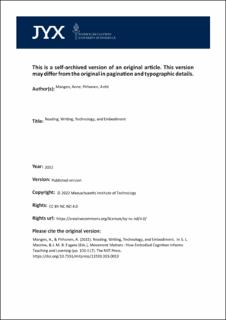| dc.contributor.author | Mangen, Anne | |
| dc.contributor.author | Pirhonen, Antti | |
| dc.date.accessioned | 2023-04-04T09:26:07Z | |
| dc.date.available | 2023-04-04T09:26:07Z | |
| dc.date.created | 2022-01-29T17:20:13Z | |
| dc.date.issued | 2022 | |
| dc.identifier.citation | Mangen, A., & Pirhonen, A. (2022). Reading, Writing, Technology, and Embodiment. In S. L. Macrine, & J. M. B. Fugate (Eds.), Movement Matters : How Embodied Cognition Informs Teaching and Learning (pp. 103-117). The MIT Press. | en_US |
| dc.identifier.isbn | 9780262543484 | |
| dc.identifier.uri | https://hdl.handle.net/11250/3062014 | |
| dc.description.abstract | The insights emerging from embodied (or 4E) cognition (Newen, et al., 2018) hold considerable promise for education, but thus far have had little impact. The widespread implementation of digital technologies in classrooms presents a timely occasion to remedy this situation. The increasing abstraction entailed in the transition from pen and paper to keyboards, and from reading in print books to reading on screens, warrants supplementing extant perspectives on learning and technologies as they are currently represented in curricula and educational policy documents. This chapter helps educators to rethink and redefine the role and meaning of technology in education broadly speaking, and describes how the use of digital technologies in the acquisition of basic skills like reading and writing specifically impacts learning from an embodied perspective. Drawing on examples from Nordic school contexts, we illustrate how 4E cognition can be pursued to benefit the learning experience in our digital age. | en_US |
| dc.language.iso | eng | en_US |
| dc.publisher | MIT Direct Press | en_US |
| dc.relation.ispartof | Movement matters : How embodied cognition informs teaching and learning | |
| dc.rights | Navngivelse 4.0 Internasjonal | * |
| dc.rights.uri | http://creativecommons.org/licenses/by/4.0/deed.no | * |
| dc.title | Reading, writing, technology and embodiment | en_US |
| dc.type | Chapter | en_US |
| dc.description.version | publishedVersion | en_US |
| dc.rights.holder | The authors | en_US |
| dc.subject.nsi | VDP::Samfunnsvitenskap: 200::Pedagogiske fag: 280 | en_US |
| dc.source.pagenumber | 103-117 | en_US |
| dc.identifier.doi | 10.7551/mitpress/13593.001.0001 | |
| dc.identifier.cristin | 1993207 | |
| dc.relation.project | NOS-HS (Nordisk samarbeidsnemnd for humanistisk og samfunnsvitenskapelig forskning): EmLearning | en_US |
| dc.relation.project | Universitetet i Stavanger: IN-10986 | en_US |
| cristin.ispublished | true | |
| cristin.fulltext | original | |
| cristin.qualitycode | 2 | |

